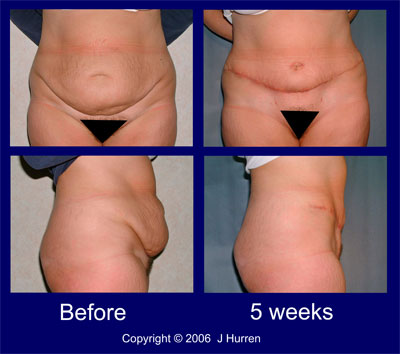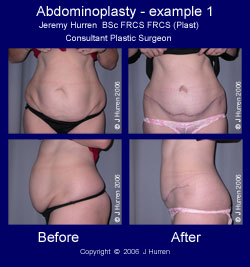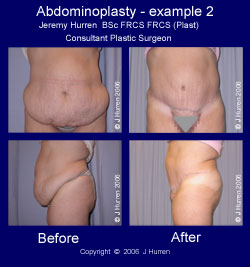ABDOMINOPLASTY (TUMMY TUCK)
What is an abdominoplasty?
An abdominoplasty is an operation to remove excess skin and fat from the lower abdomen. The abdominal wall may be tightened at the same time. It may be combined with other procedures such as liposuction or breast surgery. A mini abdominoplasty is a smaller procedure. An apronectomy is the removal of a lower abdominal skin and fat fold.
Is it right for you?
Best for excess fat and skin in lower abdomen
Especially for folds over a scar running across lower abdomen eg caesarean scar
May tighten slack or bulging tummy
It is not a substitute for weight loss but is very helpful following weight loss.
Mini-abdominoplasty is a smaller procedure that is appropriate in some instances.
If very overweight should loose weight first
The operation is best carried out once you have completed your family. Pregnancy is not a problem following an abdominoplasty but the benefit of the surgery may well be lost.
Medical considerations?
Illnesses Discuss at consultation
Obesity Lose weight before abdominoplasty
Medication Discuss all medication at your consultation including the pill
Avoid aspirin and non steroidal anti-inflammatories eg ibuprofen for 10 days before surgery
Smoking Stop smoking 4-6 weeks before surgery to reduce complications
The operation
The operation - Usually removal of the fat and skin from the umbilicus (naval) to the pubic hair. The upper abdominal skin is brought down to close the wound. The umbilicus is usually repositioned. Stretch marks lying between the naval and the pubis are normally removed but removal of all stretch marks may not be possible. Where the muscle layer of the body is stretched this may be tightened.
Anaesthetic General Anaesthetic
Minor tucks can be carried out with local anaesthetic
Duration varies but 2-4 hours
Incision / scar -long scar across lower abdomen usually can be covered with underwear
- scar around umbilicus (naval) not always necessary
- occasionally a short vertical scar is required in the middle
Your recovery?
Hospital stay come in on the day of surgery and stay 2 nights afterwards
Drains 2 drains / usually removed on the 2nd day after surgery.
Dressings Tape over the wounds. No extensive bandages
Stitches absorbable (dissolving) / under the skin (do not need to be removed)
Work Return to office type work 2-4 weeks office type work
4-6 weeks more active work
Driving 2-4 weeks
Gym / swimming 4-6 weeks gentle exercise 8-10 weeks full work out
What are the risks?
The majority of people are very pleased with the results of their surgery. All operations carry risks. Most people do not suffer significant complications. Serious, including life threatening complications are very rare. Complications can result in the need for further surgery.
General complications are those that may occur with any operation and include:
Complications of the anaesthetic.
Complications or the surgery including bleeding, infection, wound breakdown, slow healing, poor scarring (red, thick, lumpy or stretched scars. Keloid scars).
Special considerations for abdominoplasty:
Wound infection and wound breakdown can result in a significant delay in healing. Skin necrosis (skin death) may result in areas of skin loss and slow healing.
Naval (umbilicus) can loose its blood supply and die.
Reduced mobility following surgery increases the risk of clots in the legs (deep vein thrombosis). Clots can move the lungs (pulmonary embolus) where a large clot can be life threatenting.
Your new look and expectations
A flatter smoother abdomen with out a fold of loose skin and fat.
A scar across the lower abdomen which usually will lie behind suitable underwear or swimsuit
Scar across the lower abdomen usually covered by bikini bottoms. Also a scar round the umbilicus (naval). Scars are usually red for a number of months before fading. The final result of a scar varies from one person to another.
The lower abdominal skin is usually numb. The area of numbness may diminish with time.
Photographic example
Abdominoplasty, performed by Jeremy Hurren, shown before surgery and 5 weeks following surgery. Early scars may be quite red but this usually fades with time. The scar can usually be concealed by underwear or a swimsuit.


